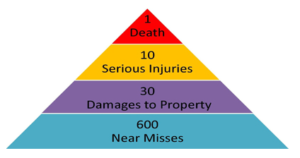
Photo credit: iStock.com/Urban 78
A subcontractor was using a rock saw to cut asphalt but not wearing eye protection. An employee saw this and asked him to stop work until he had suitable eye protection. Once the protection was in place, he was allowed to continue.
That’s one of the near-miss incidents reported in the “learnings database” on the intranet of Golder Associates, an engineering firm with 6,500 employees worldwide.
I heard about it from my friend Olivia Donaher, an archaeologist at Golder who’s been on the joint OHS committee for the past four years. In 2013, she told me about their system for communicating about safety, which I wrote about in my post Database lets workers share the learnings.
Near-miss reporting is an important topic of conversation at Golder.
“We’ve been reminding people to report near misses because we learn so much from them,” Olivia says. The reports are addressed by supervisors and the OHS committee at their monthly meetings, and sometimes elaborated into “safe work practice” bulletins archived online.
Golder includes links to these bulletins, and much more, in their weekly email newsletter Safety Share. Olivia says that “quite a lot of people read are reading Safety Share. It’s increasing health and safety awareness, and I think that’s contributing to more people reporting near misses.”

The Accident Triangle. Image from B.C. government’s Accident Prevention & Investigation page
Recently I read Near miss reports are gifts!, an article in the Fall 2016 edition of Truck LoggerBC. It was written by Cherie Whelan, director of the BC Forest Safety Council’s SAFE Companies program.
Cherie describes what’s known as the Accident Triangle concept: for every serious incident in the workplace, there are many more near miss incidents, hazards, and substandard conditions.
I asked Cherie how employers can encourage a reporting culture. She said: “Having a workplace where workers see that near misses are dealt with, followed up on, and learned from, will encourage more reporting, and better yet, ensure that deficiencies in the workplace are fixed, preventing more serious incidents from occurring — treating the reporting as a gift instead of a problem.”
In B.C., WorkSafeBC requires employers to conduct an investigation into “any incident that involves minor injury, or no injury, but had the potential for causing serious injury.”
Thanks to Olivia and Cherie for answering my questions. Here’s more information on near misses, also known as close calls and narrow escapes, among other things.
VIDEO: How to send a workplace incident report online by me, SpeakingofSafety.ca
Reference Guide for Employer Incident Investigations from WorkSafeBC
WorkSafe Bulletin: Ceiling fan falls, narrowly missing worker from WorkSafeBC
Near Miss Reporting Systems from the U.S. National Safety Council



I had a near miss at Ford Motor Canada and I was almost killed last Friday. I think they want to disappear it.
I’m glad you were not hurt, Aaron! Thank you for your comment.